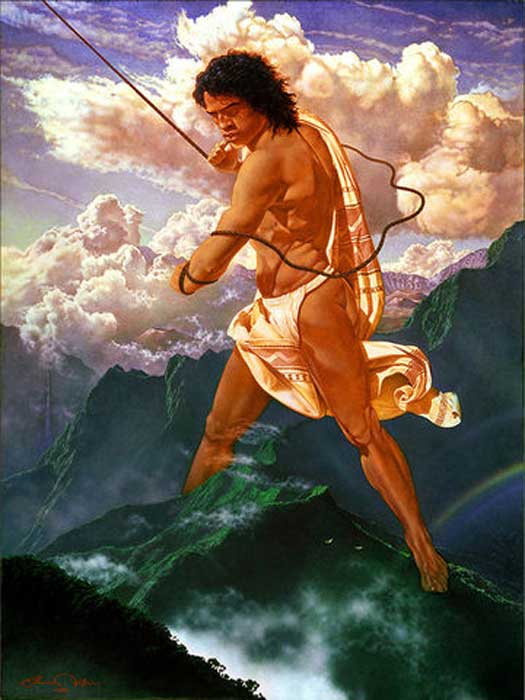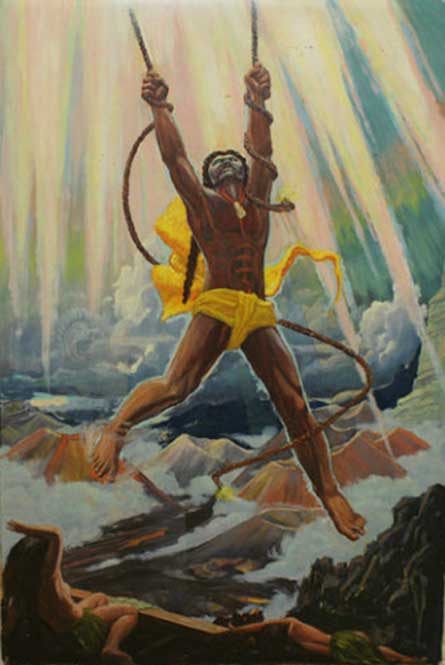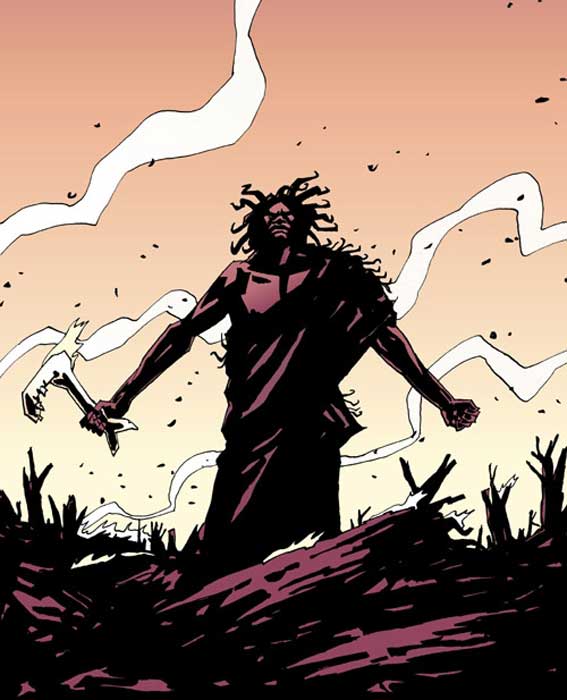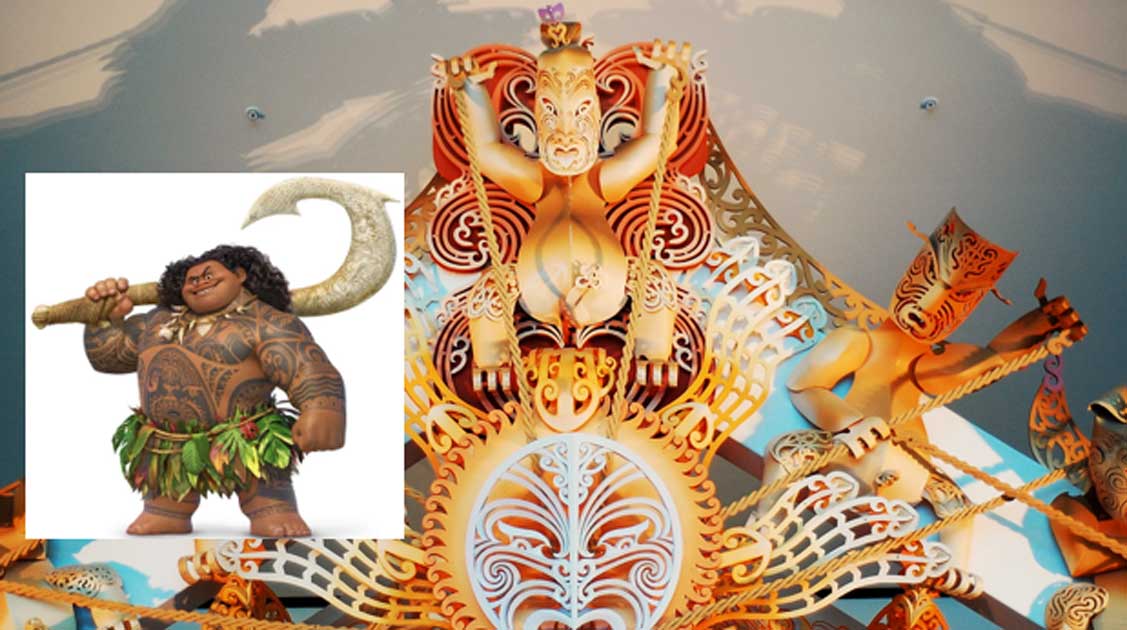Disney ALMOST Got It Right: From Moana to Mayhem, The Mythology Behind the Real Maui
Disney’s latest animated feature film, Moana, has achieved critical acclaim, already netting over half a billion dollars. It tells the story of a Polynesian princess, who must seek out Maui, a legendary demigod, to help her reunite a mystical relic with a goddess in order to save her people. But unlike most Disney flicks, the story behind Moana is not just fictional fantasy, but is based on ancient Hawaiian, Mangarevan, Tahitian, Tongan, Samoan, and Polynesian mythology.
The movie favors the Polynesian version of the myth above the others, however, Maui is still extremely important in these other cultures. In Hawaiian myth, for example, he is very prominent in their creation story, as he is responsible for passing the secret of fire to humans and slinging the sun so that it moves more slowly in the sky, making the days longer.

Maui the demigod. (CC BY SA)
A More Violent and ‘Adult’ Maui of Mythology
The Disney portrayal of Maui differs from the real mythology in that it is watered down and molded to fit into a family movie. In mythology, Maui had four brothers (who are not present in the movie) and some of his more violent or adult feats are left out of the film, to cater to a younger audience. Moreover, the movie Maui is abandoned by his parents as a child and raised by a god. Whereas, in mythology he is commonly seen as the son of a god and mortal woman - making him a demi-god.
One of the controversial choices made by the team at Disney was the physical appearance of the character. In most legends, Maui is a slim, young man coming of age, with a top-knot on his head. However, the Disney character is a beast of a man with untamed hair flowing to his shoulders. Originally, Maui was drawn to be much thinner and bald, but apparently, the size of the character was a deliberate choice after working with experts of the Oceanic Story Trust. The Disney version was intended to look large and heroic.
- The Menhune of Hawaii – Ancient Race or Fictional Fairytale?
- Secret and Safe: Hawaiian Royal Burials and the Missing Bones of Kamehameha the Great
- Perseus: Powerful Demigod wth Mighty Weapons

Left: A more traditional depiction of Maui. (TEARA/CC BY NC 3.0 nz) Right: The Disney version of Maui. (CC BY SA)
Some Consistency in the Maui Myths
While there is variance in Maui’s legends throughout the areas his mythology can be found, there are two consistent stories. The first is the story of Maui creating islands. To complete this task Maui convinced his brothers to take him on a fishing trip. While they were fishing, Maui caught his magical fishing hook on the ocean floor and convinced his brothers to paddle as hard as they could, telling them that he had caught a massive fish. Instead, Maui shored up several islands that would make up the islands of Hawaii (and many others).
The second myth that can be agreed upon is that of Maui’s restraining of the sun. In this, Maui lassoed the sun with his sister’s hair in an effort to help his mother, punishing the sun until it agreed to give the islands long days in the summer and short days in the winter. In another version, Maui takes the jaw-bone of his ancestress Muri-ranga-whenua and used this as a weapon to beat the sun into submission in order to help mortals get their work done, in addition to helping his mother.

The Demigod Maui Snaring the Rays of the Sun. (1951) By Paul Rockwood. (National Park Service)
Maui Says “You’re Welcome”
The lyrics to Maui’s song, “You’re Welcome,” in the Disney movie closely follow the Polynesian myths. It recounts how he consistently aided humans in his time. In Polynesian mythology, Maui is seen as a demi-god known for this mischievous nature as well as his iconic magical fishing hook, made from the jaw bone that he took from Muri-ranga-whenua.
Polynesian culture also attributes the creation of their islands to Maui, like many other cultures that hold Maui in their mythology. Going one step further from the Hawaiian myth explained above, the Polynesian myth says that on a fishing trip with his brothers Maui uses blood from his own nose and his jaw-bone fishing hook to haul up a great fish from the depths of the ocean.
Once caught, Maui goes in search of a priest that could perform the appropriate ceremonies and prayers over the fish. Maui’s brothers, however, did not wait for him to return and cut up the fish immediately. Grabbing for their share of the fish, the animal broke up into mountains, cliffs, and valleys. Had the brothers listened to Maui, legend says the island would have been a flat plain, enabling the people living there to travel across it with ease.
- Creation Myth of the Maori – New Zealand
- Huge Waves Provide Rare Glimpse of Hawaiian Petroglyphs
- Mokomokai: Preservation of the Tattooed Maori Heads of New Zealand

A. W. Reed. Maui: Legends of the Demigod of Polynesia. Wellington: A. H. & A. W. Reed, 1943. (Deriv.) Source: Reed Gallery
Maui and the Fire Myth
Maui, in Polynesian myth, is said to be the offspring of Taranga, the wife of Makeatutara. His miraculous birth involves his mother throwing the premature infant into the ocean wrapped in some of her own hair. Ocean spirits find the boy and wrap him in seaweed. His ancestor, Rangi, took the child and raised him to adolescence, when he set out in search of his mother and brothers.
Another popular myth involving Maui is the discovery of fire. Maui discovers that fire has been lost on the earth. As such, he goes in search of the fire-goddess, Mahuika, and learns the secret art of obtaining fire. At the same time, his tricks make her furious, and while he succeeds in his task of learning the art of fire, he barely escapes with his life. He transforms himself into a hawk, but this only further infuriates the fire-goddess, who proceeds to set both land and sea on fire. Maui then prayed to his ancestors, who brought a great rain to extinguish the flames.

The hero of Polynesian mythology Māui is shown holding the jawbone of his ancestor Murirangawhenua. (TEARA/CC BY NC 3.0 nz)
Maui met his end while performing his final trick on the Goddess Hine-nui-te-po. In an attempt to make mankind immortal he entered the goddess in the guise of a worm. However, while exiting her body he was crushed to death by her obsidian teeth.
Top Image: Carving of Māui capturing the sun. From Te Hono ki Hawaiki at the Museum of New Zealand Te Papa Tongarewa. Source: Daniel Pietzsch/CC BY NC 2.0
Resources
Wendrof, J.A. (2016) ‘Is The Maui Legend From 'Moana' Real? The Demigod Has A History.’ https://www.romper.com/p/is-the-maui-legend-from-moana-real-the-demigod-has-a-history-23222
Cobb, K. (2016) ‘Your Cheat Sheet On The Legends Behind Disney’s ‘Moana.’’ http://decider.com/2016/11/28/the-legends-behind-disneys-moana/
Tahiti-Infos (2015) ‘The true origins of Disney princess Moana.’ http://www.tahiti-infos.com/The-true-origins-of-Disney-princess-Moana_a142314.html




















Comments
... This is a Māori legend. Maui didn't pull up the the islands of Hawaii. It's New Zealand. Come on. You ALMOST got your facts right.
It literally mentions the city 'Auckland' with landmarks like its Harbour bridge and 'Sky Tower'
Cheers on the false information.
Actually, almost all Disney stories are based off of folk tales, myths and mythology. I mean what do you think Hercules or Mulan were based off of? The ones that weren't we're based off of classic literature.
I don’t know much about Polynesian mythology. Thank you for posting
Actually, Maui was not a person but the name of a Race of giant pale skinned, red headed, blue/green eyed beings who reveled in mighty beards and roamed all of the earth...They came into being after the earth had resumed a normal spin following a massive meteor strike, lived through the World flood myth as they were partly responsible for it and helped re-establish settlements as well as feasted on humans in some cases ( good and bad amongst all peoples)...They are depicted in Easter Island and NZ old carvings...
Interesting comment. Could you provide a source?
Pages